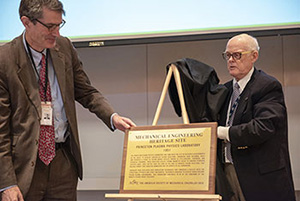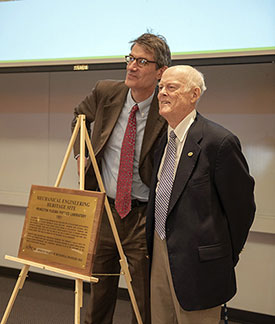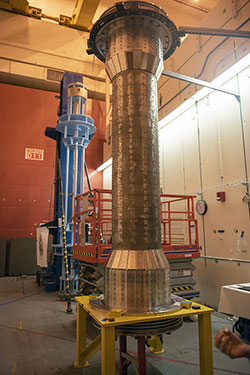Plasma Physics Laboratory is Named Latest ASME Mechanical Engineering Heritage Site
Plasma Physics Laboratory is Named Latest ASME Mechanical Engineering Heritage Site
The Princeton Plasma Physics Laboratory (PPPL) was recognized for its significance to the advancement of fusion energy and plasma physics research when it was recently designated as an ASME Mechanical Engineering Heritage Site. The designation ceremony took place on Oct. 5 at Princeton University’s MBG Auditorium in Princeton, N.J.
Since it was founded in 1951 by Princeton University professor Lyman Spitzer, the laboratory has been the site of many notable research efforts, including Dr. Spitzer’s development of the stellarator, a device that could confine plasmas in a figure-eight shaped tube with the use of external magnets, marking the beginning of magnetic fusion research at Princeton.
Researchers at the laboratory have since designed, built and operated stellarators and other fusions energy devices, such as tokamaks and spherical tokamaks, which employ strong magnetic fields to contain ultra-high-temperature hydrogen isotopes in order to produce energy through the process of magnetic fusion. Although fusion research is conducted at other research institutions inside and outside the United States, PPPL has maintained its position as the lead laboratory for fusion energy and plasma physics in the United States.
“Engineers here developed new fabrication techniques that produced a facility with the structural strength and strict mechanical tolerances required to achieve world-record fusion plasma performance,” states the plaque describing this ASME Mechanical Engineering Heritage Site, which will be displayed at PPPL. “This laboratory continues to be at the forefront of the world’s fusion energy research.
The casing of the center stack of the National Spherical Torus Experiment Upgrade (NSTX-U) at the Princeton Plasma Physics Laboratory. The center stack houses the central sections of the toroidal coils plus the coils that induce current in the plasma to twist the magnetic field. (Photo by Wil Haywood, Strategic Communications)
Approximately 100 people took part in the ceremony, including ASME Past President Robert Simmons, who presented the plaque to PPPL Director Steve Cowley; Jim Van Dam, acting associate director of the U.S. Department of Energy’s Office of Fusion Energy Sciences, who spoke during the ceremony; and Rich Hawryluk, interim deputy director for operations at PPPL, who provided closing remarks for the event. Others in attendance included Dave McComas, Princeton vice president for PPPL; Dale Meade, former PPPL deputy director; Lee Langston, member of the ASME History and Heritage (H&H) Committee; and members of the Princeton and PPPL staff and the ASME H&H Committee.
For more information on the ASME Historic Mechanical Engineering Landmarks Program, visit www.asme.org/about-asme/engineering-history/landmarks.






